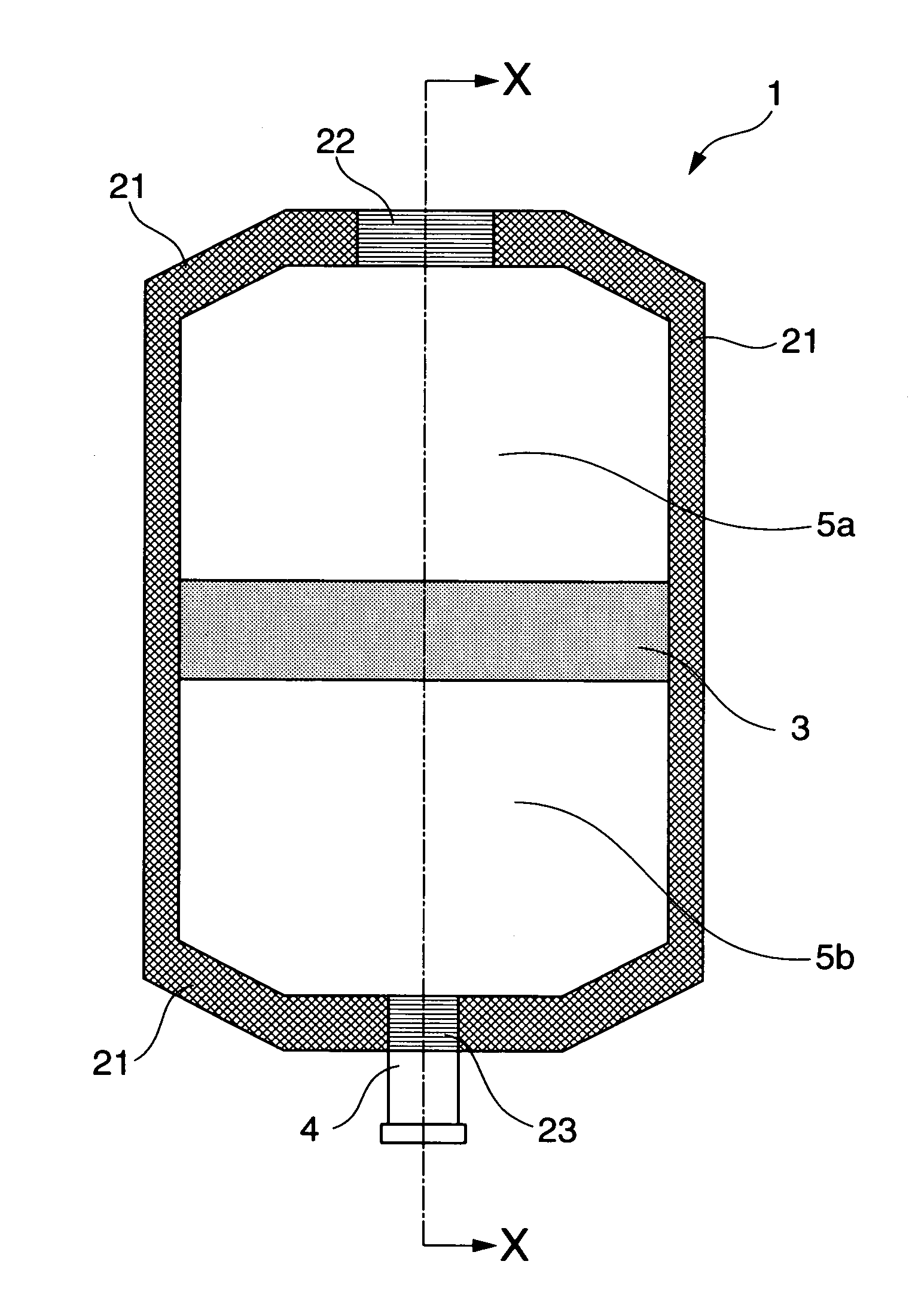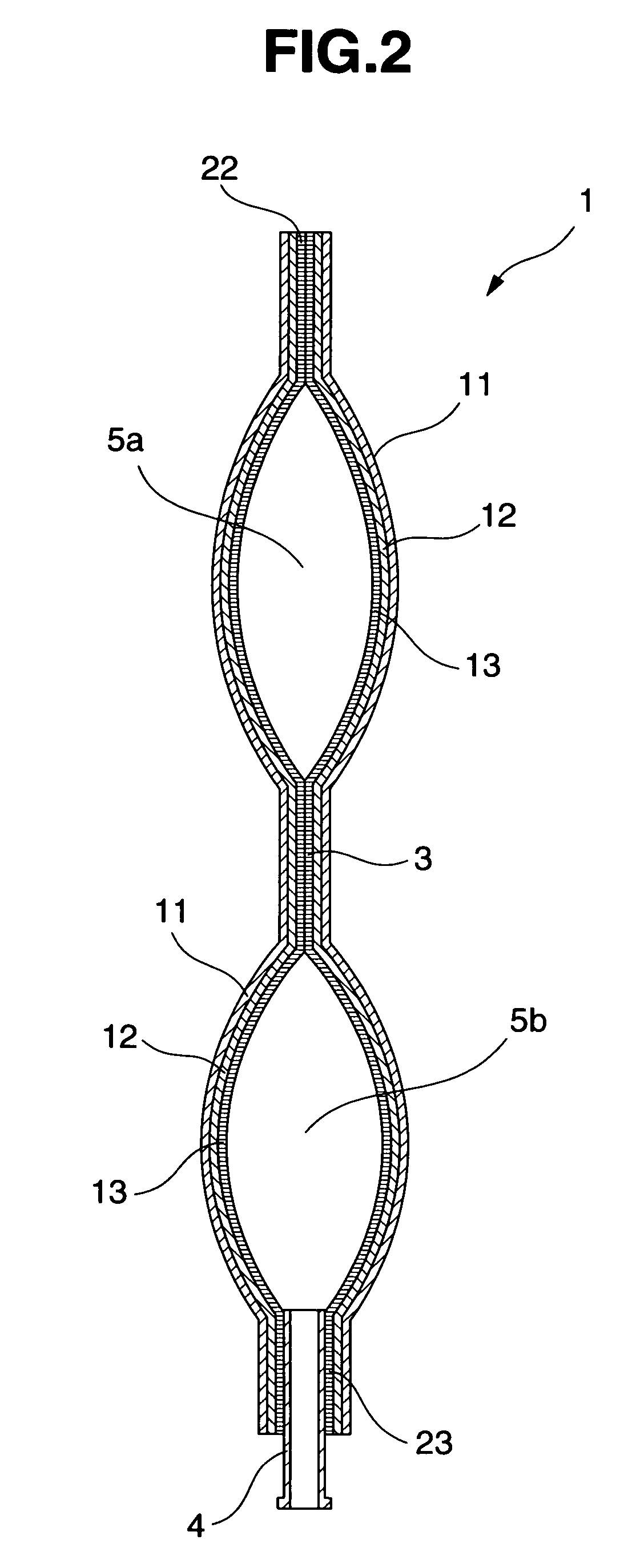Multi-chamber container
a multi-chamber, container technology, applied in the field of containers, can solve the problems of poor heat resistance of polymer compositions, unsuitable sterilization, and container breakage or deformation, and achieve the effects of good transparency, high heat resistance, and comparatively small change of seal strength
- Summary
- Abstract
- Description
- Claims
- Application Information
AI Technical Summary
Benefits of technology
Problems solved by technology
Method used
Image
Examples
example 1
[0094]A sheet 1 with a total thickness of 200 μm, which consists of a surface layer with a thickness of 20 μm, an intermediate layer with a thickness of 140 μm, and a heat-sealable layer with a thickness of 40 μm, was prepared by multi-layer coextrusion from the following materials.[0095]Material for the surface layer: A composition composed of component (a) defined below and propylene homopolymer in a ratio of 9:1.[0096]Material for the intermediate layer: A composition composed of component (a) defined below and metallocene plastomer (“Kernel” from Japan Polychems, Inc.) having a tensile modulus of 100 MPa in a ratio of 8:2.[0097]Material for the heat-sealable layer: A composition composed of component (a) defined below and component (b) defined below in a ratio of 6:4.
[Component (a)]
[0098]A reactor-type propylene-based TPO (Thermoplastic Olefin Elastomer) (from Mitsubishi Chemical Corporation), which gives such a specific ratio of the amount of elution measured by the temperature...
example 2
[0103]A sheet 2 with a total thickness of 200 μm, which consists of a surface layer with a thickness of 20 μm, an intermediate layer with a thickness of 140 μm, and a heat-sealable layer with a thickness of 40 μm, was prepared by multi-layer coextrusion from the following materials.[0104]Material for the surface layer: A composition composed of component (a) defined above and propylene homopolymer in a ratio of 9:1.[0105]Material for the intermediate layer: A composition composed of component (a) defined above and a styrene-based elastomer containing 20% styrene (“Hybrar” from Kuraray Co., Ltd.) in a ratio of 9:1.[0106]Material for the heat-sealable layer: A composition composed of component (a) defined above and component (b) defined above in a ratio of 7:3.
[0107]The thus obtained sheet 2 was heat-sealed at 200° C. and 0.5 MPa for 4 seconds to form the peripheral sealed part and the port sealed part. Then it was heat-sealed at 160° C. and 0.2 MPa for 2 seconds to form the weakly se...
example 3
[0109]A sheet 3 with a total thickness of 250 μm, which consists of a surface layer with a thickness of 20 μm, an intermediate layer with a thickness of 180 μm, and a heat-sealable layer with a thickness of 50 μm, was prepared by multi-layer coextrusion from the following materials.[0110]Material for the surface layer: A composition composed of component (a) defined above, component (b) defined above, and propylene homopolymer in a ratio of 8:1:1.[0111]Material for the intermediate layer: A composition composed of component (a) defined above, component (b) defined above, and a metallocene plastomer (“Kernel” from Japan Polychems, Inc.) having a tensile modulus of 80 MPa in a ratio of 6:2:2.[0112]Material for the heat-sealable layer: A composition composed of component (a) defined above and component (b) defined above in a ratio of 7:3.
[0113]The thus obtained sheet 3 was heat-sealed at 210° C. and 0.5 MPa for 4 seconds to form the peripheral sealed part and the port sealed part. Then...
PUM
| Property | Measurement | Unit |
|---|---|---|
| temperatures | aaaaa | aaaaa |
| temperatures | aaaaa | aaaaa |
| total light transmittance | aaaaa | aaaaa |
Abstract
Description
Claims
Application Information
 Login to View More
Login to View More - R&D
- Intellectual Property
- Life Sciences
- Materials
- Tech Scout
- Unparalleled Data Quality
- Higher Quality Content
- 60% Fewer Hallucinations
Browse by: Latest US Patents, China's latest patents, Technical Efficacy Thesaurus, Application Domain, Technology Topic, Popular Technical Reports.
© 2025 PatSnap. All rights reserved.Legal|Privacy policy|Modern Slavery Act Transparency Statement|Sitemap|About US| Contact US: help@patsnap.com



